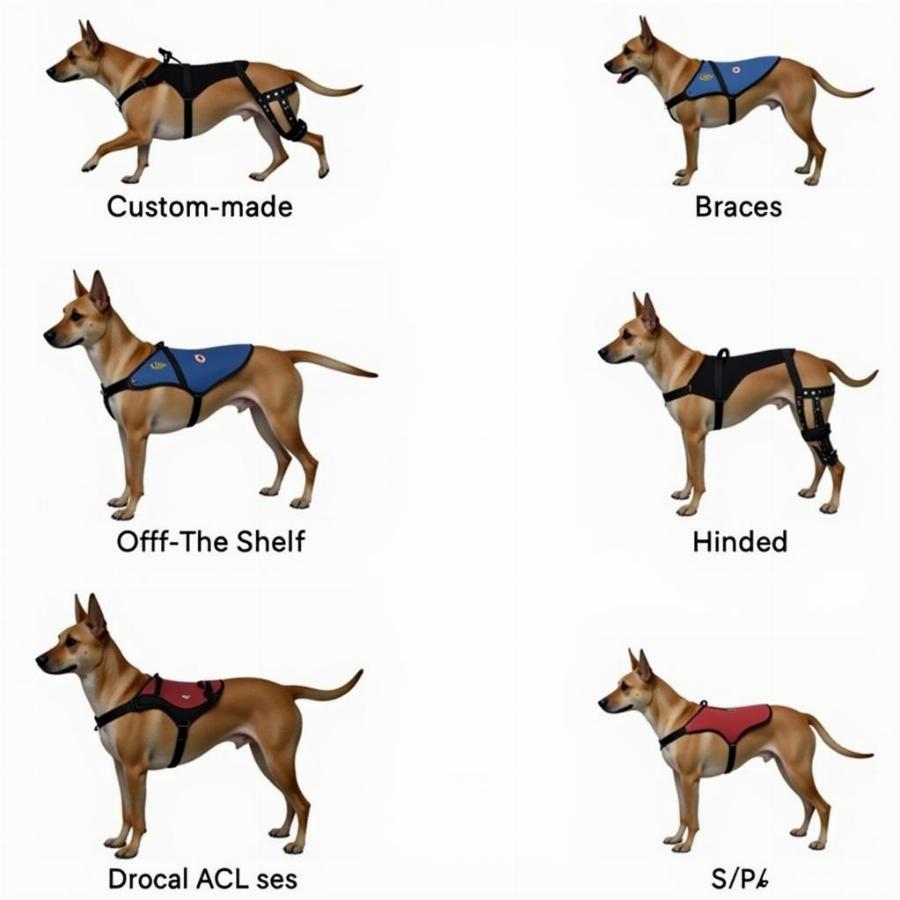A torn ACL (Anterior Cruciate Ligament), or more accurately in dogs, CCL (Cranial Cruciate Ligament), is a common and painful injury. Braces for dogs acl can play a crucial role in managing this condition, offering support and stability to the affected joint. Understanding the different types of braces, their benefits, and how to properly use them is essential for any dog owner dealing with this challenging injury. This comprehensive guide will delve into everything you need to know about braces for dogs acl, providing you with the knowledge to help your furry friend recover.
Understanding Canine ACL (CCL) Injuries and the Role of Braces
Canine ACL tears, often referred to as CCL tears, are a debilitating injury that can significantly impact a dog’s mobility and quality of life. Similar to the ACL in humans, the CCL in dogs stabilizes the knee joint. When this ligament is torn, either partially or completely, the joint becomes unstable, causing pain, lameness, and difficulty bearing weight. Braces for dogs acl are designed to provide external support to the injured joint, mimicking the function of the damaged CCL. This added stability helps alleviate pain, improve mobility, and promote healing.
Types of Braces for Dogs ACL
There are various types of braces available, each designed with specific features and levels of support. Understanding the differences can help you choose the most appropriate brace for your dog’s individual needs. Common types include:
- Custom-made braces: These braces are specifically designed and fitted to your dog’s leg, offering the highest level of support and comfort.
- Off-the-shelf braces: These are pre-made braces available in various sizes. While more affordable, they may not provide the same level of personalized fit as custom-made options.
- Hinged braces: These braces incorporate hinges to allow for a more natural range of motion while still providing stability.
- Soft braces: These offer less support but can be beneficial for mild injuries or during post-operative recovery. A dog brace for acl tear can be especially beneficial during this recovery phase.
 Different Types of Dog ACL Braces Available
Different Types of Dog ACL Braces Available
Benefits of Using Braces for Dogs ACL
Braces offer several benefits for dogs suffering from CCL injuries, both as a non-surgical treatment for ccl in dogs and in conjunction with surgery:
- Pain Relief: By stabilizing the joint, braces reduce painful movement and inflammation.
- Improved Mobility: The added support allows dogs to move more comfortably and with greater ease.
- Enhanced Healing: Stability promotes healing by reducing stress on the injured tissues.
- Reduced Risk of Re-injury: Braces can help prevent further damage to the CCL and surrounding structures.
- Alternative to Surgery: In some cases, especially for mild injuries or older dogs, bracing can be a viable alternative to surgery. A stifle brace for dogs can be a good option in these scenarios.
Choosing the Right Brace and Ensuring Proper Fit
Selecting the right brace for dogs back leg requires careful consideration of factors such as the severity of the injury, your dog’s size and activity level, and your veterinarian’s recommendations. Ensuring a proper fit is crucial for both comfort and effectiveness. A poorly fitted brace can cause discomfort, rubbing, and even further injury. Consulting with your veterinarian or a certified canine rehabilitation specialist is highly recommended for guidance on brace selection and fitting. They can also provide advice on using a dog recovery collar to prevent the dog from interfering with the brace.
Living with a Braced Dog: Tips and Considerations
Adapting to life with a braced dog requires patience and understanding. Your dog may initially resist the brace, requiring gradual acclimation. Regular monitoring for any signs of discomfort or rubbing is essential. Additionally, you may need to adjust your dog’s activity level and provide appropriate exercise and rehabilitation.
Conclusion
Braces for dogs acl offer valuable support and can significantly improve the quality of life for dogs suffering from CCL injuries. By understanding the different types of braces, their benefits, and how to properly use them, you can play an active role in your dog’s recovery and help them regain their mobility and comfort.
FAQ
- How long will my dog need to wear a brace?
- Can my dog sleep with the brace on?
- What are the signs of a poorly fitted brace?
- Can braces be used for other leg injuries?
- How do I clean my dog’s brace?
- Are there any alternatives to bracing for CCL tears?
- What is the typical cost of a dog ACL brace?
Other questions you might have:
- How to manage post-surgery recovery in dogs with ACL tears?
- What are the best exercises for dogs with ACL injuries?
Beaut Dogs is your trusted source for all things canine, offering expert advice and valuable insights into the world of dog care. We provide comprehensive information on various dog breeds, health issues, training tips, and product recommendations to help you give your furry friend the best possible care. For personalized support and answers to your specific questions, please contact us at Email: [email protected]. We are here to help you navigate the journey of dog ownership and ensure your beloved companion thrives. Visit us at Beaut Dogs.